When the weather turns cold, it’s time to break out the woolen blankets and sweaters. But have you ever stopped to think about where this cozy fabric comes from? It turns out, there are a whole host of animals that yield wool, and they’re not all sheep! Here are some of the fuzziest, fluffiest, and frizziest animals that yield wool and help us stay warm.
What is Wool?
Wool is a protein fiber that comes from the fleece of sheep and other animals. It is composed of overlapping scales of keratin — the same protein found in human hair and nails. Wool has a number of unique properties that make it ideal for a variety of uses, including clothing, carpets, and upholstery.
The wooly hair is sheared from the animal’s body, and then cleaned and carded before being spun into yarn. It is one of the strongest natural fibers and is resistant to stretching. Wool is also absorbent and can absorb up to 30% of its weight in moisture without feeling damp. And do you know that wool is naturally fire-resistant? That’s right — wool can actually self-extinguish when it comes into contact with an open flame!
As you can see, there’s more to wool than meets the eye. This versatile material comes from a variety of animals, each with their own distinct benefits. Here’s a rundown of some of the most popular sources of wool:
1. Sheep

Sheep is the most common wool source.
©iStock.com/MarjanVisser
The most common source of wool, sheep provide a versatile and durable type of wool that is perfect for a wide range of applications. There are over 200 different types of domestic sheep, which produce all types of wool. Sheep are often categorized based on the type of hair they have, or the type of wool they produce, from fine wool to coarse wool to hairlike and more. They also come in a wide variety of different colors, although white is the most popular since it is the easiest to dye.
Merino sheep produce some of the highest quality wool. The wool from a merino sheep is very fine, soft, and non-irritating, making it ideal for garments that will be worn next to the skin. Merino wool is also very absorbent, making it great for sportswear as it will wick away sweat.
2. Alpacas
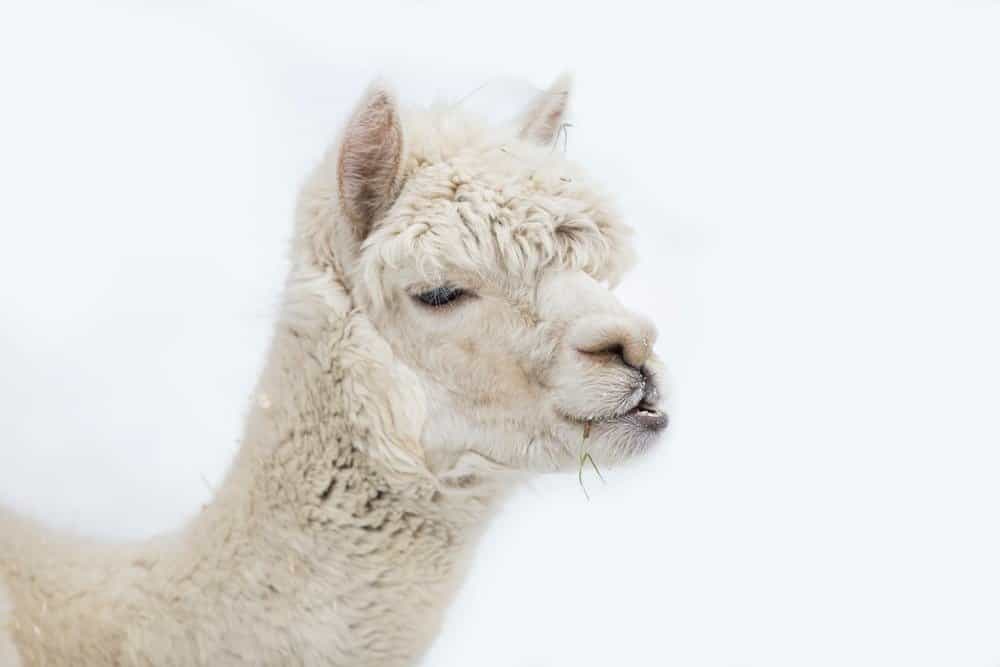
Alpacas are raised specifically for their fiber.
©Mircea Costina/Shutterstock.com
Native to the Andes Mountains in South America, alpacas are those lovable, fluffy creatures that look like a cross between a llama and a sheep. There are two types of alpacas: the Huacaya and the Suri. The Huacaya is the most common, and it has dense, crimped fiber that grows perpendicular to the body. The Suri, on the other hand, has lustrous fiber that grows in pencil-like locks parallel to the body.
Alpacas are farmed specifically for their fiber, which is incredibly soft and warm. They produce a finer grade of wool than llamas, and it does not have any coarse guard hairs. In fact, alpaca fiber is often compared to cashmere, making it a coveted material for high-end winterwear. Alpacas come in a variety of colors, but most commonly you’ll find them in shades of white, brown, and gray. They are typically sheared once a year or every two years in the spring.
3. Rabbits
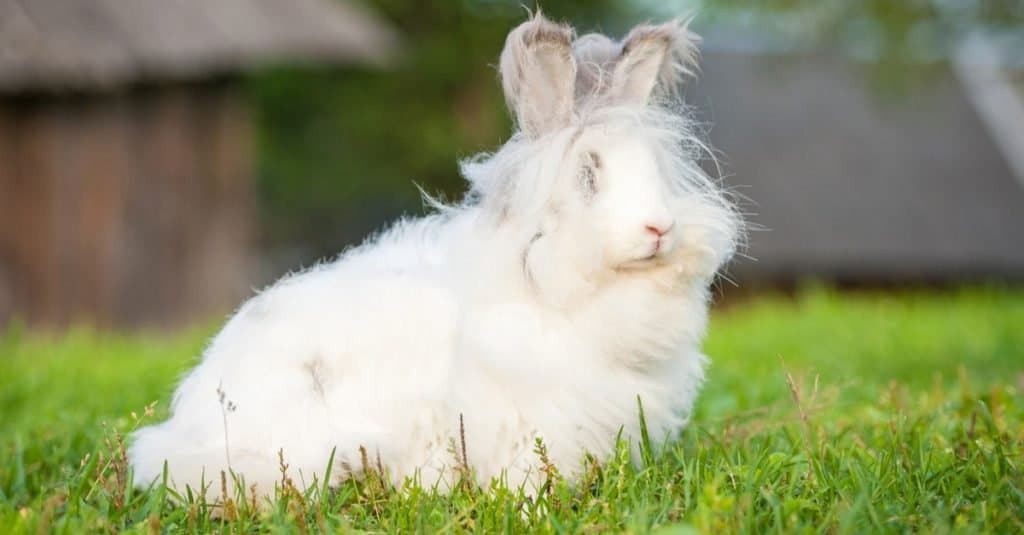
Angora rabbits yield a type of wool called Angora fiber.
©Rita_Kochmarjova/Shutterstock.com
Bunnies are soft and cuddly, and believe it or not — bunnies also yield wool! Rabbits are one of the smallest animals that yield wool. There are actually several types of rabbits that have been bred over the centuries for their fur, although the Angora rabbit is probably the most popular. Angora rabbits are originally from Turkey and yield a type of wool known as Angora fiber. The fiber is much finer than sheep’s wool and is often used to make sweaters, scarves, and other delicate clothing items.
Angora rabbits boast long, silky fur that requires careful grooming to prevent matting. It is very light and airy, making it ideal for summer garments or layering in the wintertime. Unlike sheep, Angora rabbits are brushed to collect their fur, rather than sheared. They are usually combed out every three months or so, and sometimes their fur is combined with sheep’s wool to make it a bit more durable.
4. Goats
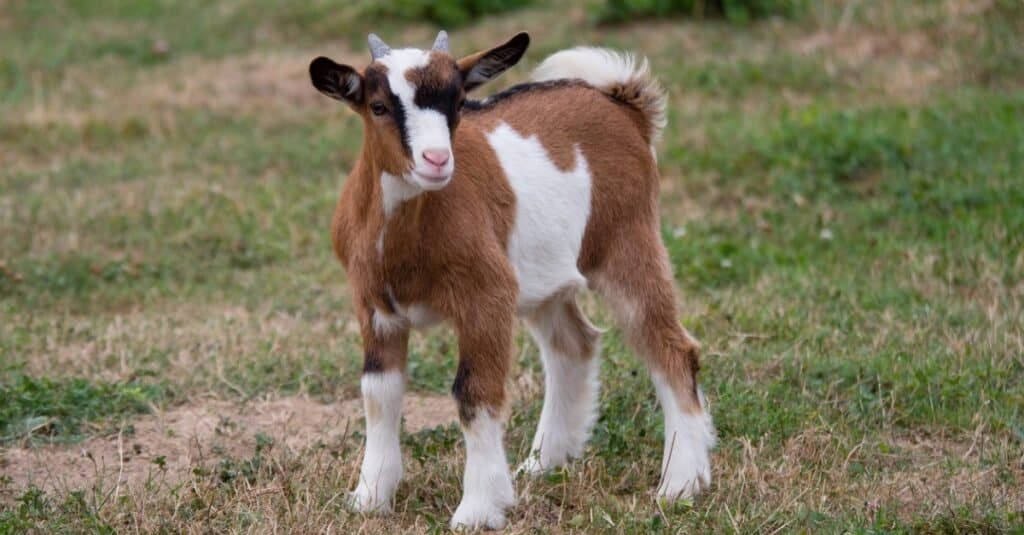
Goats produce two main types of wool.
©Andrea Kraus-Wirth/Shutterstock.com
There are two main types of wool that come from goats: cashmere and mohair. Cashmere comes from cashmere goats, which are native to Central Asia and yield a soft, downy fiber that is often used in high-end garments. In fact, it is one of the most expensive types of wool in the world. The fibers are extremely soft and can be used to make pricey sweaters, shawls, and other luxury items.
Mohair comes from the long, shaggy coats of Angora goats. It is a strong yet lustrous fiber that is also quite durable. While it can be difficult to work with due to its slippery texture, it is well known for its beautiful luster and is often used to make fine yarn, shawls, and other clothing items.
5. Llamas
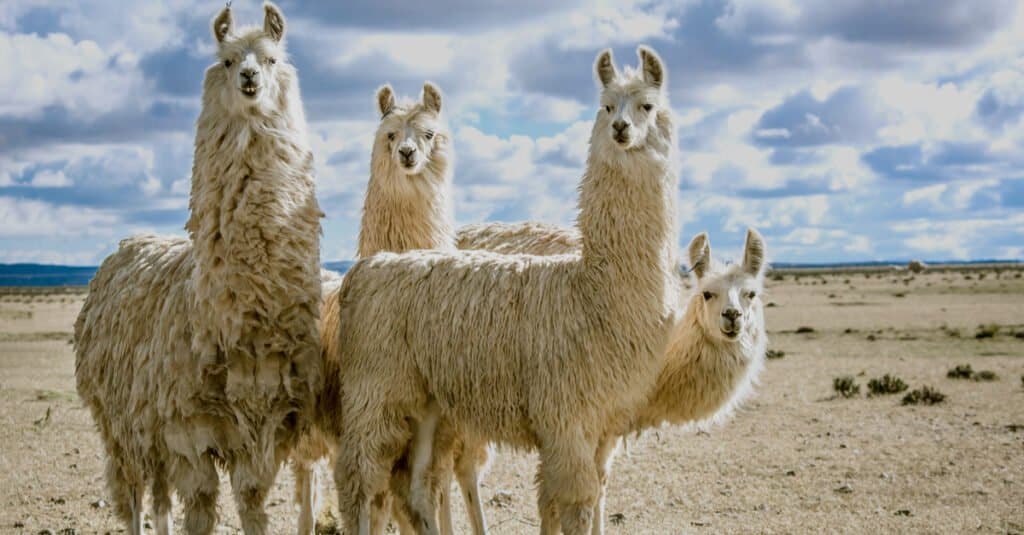
Llamas have wooly coats.
©Noe Besso/Shutterstock.com
Native to South America, llamas are closely related to alpacas (so much so that they can even interbreed!). However, llamas are bigger than alpacas and are not typically farmed for their fiber. Instead, these furry creatures are used as pack animals in their native South America.
However, llamas do have wooly coats and are one of the animals that yield wool. They produce a coarse type of wool with stiff guard hairs that are often used in rugs, ropes, and blankets. Llama fiber is coarser than alpaca fiber but can still be used to create warm garments, especially if the guard hairs are removed.
6. Camels

Camels produce wool.
©Wolfgang Zwanzger/Shutterstock.com
We all know that camels are tasked with the impressive ability to store water in their humps, but what you may not know is that some camels also happen to produce wool. The highest quality camel wool comes from the Bactrian camel.
The Bactrian camel has two humps and a shaggy coat. These camels are mostly used in Mongolia, and their hair is strong yet extremely soft (some even compare it to cashmere). Since Bactrian camels shed their winter coats naturally each spring, they do not need to be sheared. Instead, people can trail behind the camels and pick up the hair as they go.
7. Guanacos
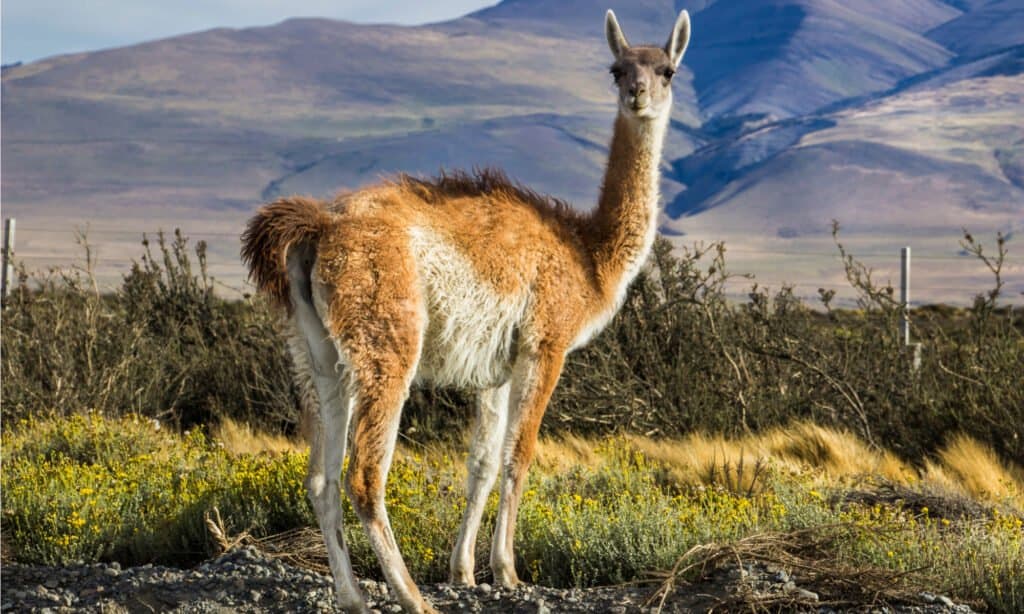
The wool from guanaco is very versatile.
©abriendomundo/Shutterstock.com
Another relative of the llama in South America, the guanaco produces very fine and soft fur. However, these animals are not domesticated, and they are not kept in captivity or bred for their wool. Instead, guanacos are captured and sheared occasionally before being returned to the wild. Guanacos are rarer than their other wool-yielding cousins, and their wool is sustainably harvested to protect their smaller populations.
Guanaco wool is extremely versatile, offering excellent protection from the elements while retaining a luxuriously soft feel against the skin. It is considered the second finest natural fiber in the world, following closely behind that of the vicuña.
8. Vicuñas
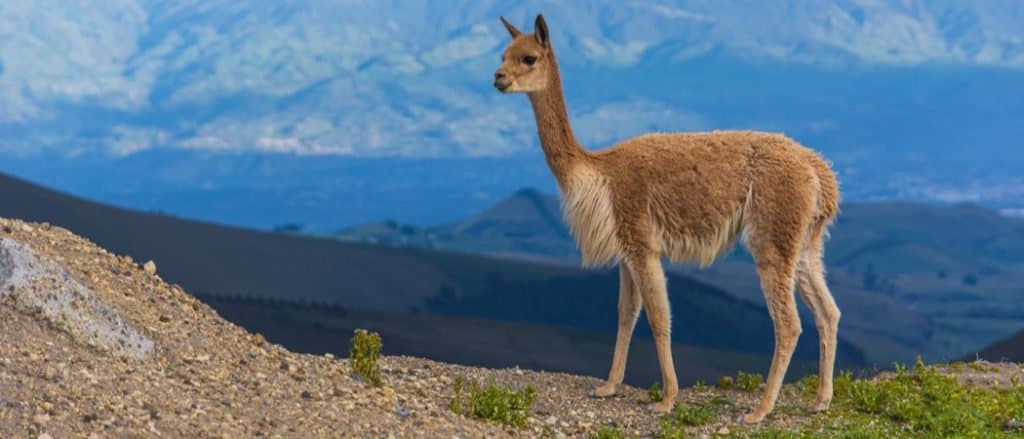
Vicunas produce the finest natural fiber in the world.
©ecuadorplanet/Shutterstock.com
The rarest and most highly prized wool in the world comes from the vicuña. Vicuña wool is shorn from the national animal of Peru, the vicuña. These wild cousins of the llama are only found in the high alpine areas of the Andes Mountains. Vicuñas must be temporarily captured from the wild to harvest the hair, and they are only sheared once every three years. This allows their coat to grow back fully, keeping them cozy and comfortable in even the harshest climates.
The actual fibers of vicuña wool are very fine, measuring in at about 8-14 microns in diameter. For reference, human hair is about 70-100 microns in diameter. This makes vicuña wool extremely soft and very valuable. In fact, vicuña wool is considered to be the finest natural fiber in the world! It is softer than cashmere and more resilient than silk, making it truly unique. In addition to being soft, vicuña wool is also lightweight and has great insulation properties, making it perfect for cold-weather clothing.
9. Yaks

Yak wool is known for its warmth and durability.
©SakSa/Shutterstock.com
The largest animal that yields wool is the yak, a long-haired bovine native to the Himalayan region of Central Asia. Historically, yaks have been used as pack animals, for their milk and meat, and for their hides, which are used to make tents, rugs, and ropes. More recently, however, people have begun to harvest yak wool for use in fabrics and yarns. Yak wool is especially prized for its softness, warmth, and durability.
You might be wondering why anyone would want to try to harvest hair from these large creatures, but it turns out that yak hair is extremely fine – 16-18 microns – which makes it incredibly soft. However, despite its fine texture, yak wool stores body heat extremely well. It is both lightweight and durable and can protect from freezing temperatures. Yak wool is most commonly used for making outerwear, such as coats and hats, and sometimes it is used for making blankets and other textiles.
10. Musk Oxen
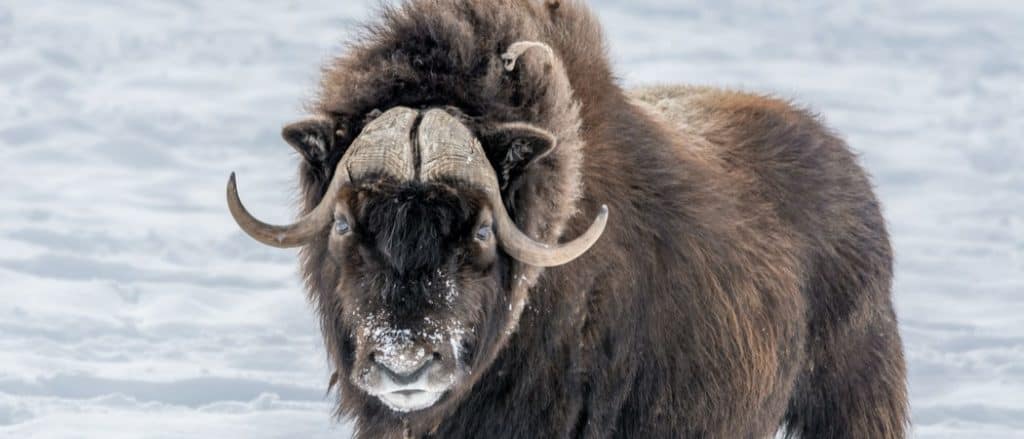
The wool from musk ox is harvested naturally.
©Fitawoman/Shutterstock.com
Native to cold northern climates like Greenland, Alaska, and Siberia, musk oxen are large, hairy animals that look like a cross between a bison and a sheep. While they may not be the most attractive creatures in the world, musk oxen produce some of the finest wool around — even softer than cashmere! In fact, musk ox wool is so coveted that people are willing to brave sub-zero temperatures and icy waters just to get their hands on it.
The soft inner wool of a musk ox is called qiviut, and it is highly prized with the right processing. Qiviut, or musk ox wool, is unlike any other type of wool out there. It’s incredibly soft, yet strong and durable at the same time. It only has 12-14 microns, but it is eight times warmer than sheep’s wool! Qiviut is also much less scratchy and oily, so it can be a great alternative for those who are allergic to sheep’s wool. One of the great things about musk ox wool is that it is harvested naturally. Since these large animals shed their hair in big chunks, it does not need to be sheared.
So, next time you’re bundling up against the winter cold, take a moment to appreciate all the hard work that went into your woolen sweater! These animals may not be as cuddly as your average house pet, but they sure do provide us with a lot of warmth and happiness during the colder months of the year.
Up Next:
Thank you for reading! Have some feedback for us? Contact the AZ Animals editorial team.








